It’s almost the New Year! The Irish word for New Year’s Day is ‘Lá Caille’ which sounds slightly different in various parts of the country – Connaught, Munster and Ulster each have their own pronunciations. These can be heard here.
I was never aware of any particular New Year traditions when growing up in Ireland 60 years ago. A quick search on the Duchas Schools Collection* however found several references to customs that have now sadly died out. (In the Irish transcriptions the day is given as ”Lá Coille”)
 One scholar in Kilcurry School in Dundalk tells us that church bells and fog horns of boats and ships would ring the old year out and the New Year in at 12 o’clock, whereas in another there was a practice of tolling a slow bell in the last minute of the old year before the joyful ringing in of the New.
One scholar in Kilcurry School in Dundalk tells us that church bells and fog horns of boats and ships would ring the old year out and the New Year in at 12 o’clock, whereas in another there was a practice of tolling a slow bell in the last minute of the old year before the joyful ringing in of the New.
 New Year memories of Peadar Ó Cadhla of Ballytrisane Co. Waterford, as recorded by Maighread Ní Cadhla (Duchas Schools Collection)
New Year memories of Peadar Ó Cadhla of Ballytrisane Co. Waterford, as recorded by Maighread Ní Cadhla (Duchas Schools Collection)
Here we learn from Peadar that the first person up that morning makes three circuits of the house. On the first two rounds he stops at the door and says ”The Blessings of God in here”. On the final circuit he enters the house dispensing blessings to all inside who respond appropriately.
There are several references to the first visitor to the house on New Year’s Day from many parts of the country. They consistently say that if the visitor is male and dark haired there will be good luck in the house for the entire year. If the first visitor is female however there will be no luck during the year.
 Séan Ó Maolchaoine from Kilfenora Co Clare tells us that and if a red-haired woman is first to enter there will be no luck whatsoever in that house for the entire year. It seems that red-haired women are really bad news at this important time! The similar tradition of ‘First Footing’ (or the first foot in the house after midnight) is still common across Scotland, where the ‘first foot ‘should be that of a dark-haired male, to bring good luck for the year.
Séan Ó Maolchaoine from Kilfenora Co Clare tells us that and if a red-haired woman is first to enter there will be no luck whatsoever in that house for the entire year. It seems that red-haired women are really bad news at this important time! The similar tradition of ‘First Footing’ (or the first foot in the house after midnight) is still common across Scotland, where the ‘first foot ‘should be that of a dark-haired male, to bring good luck for the year.
A ‘folk belief’ or superstition is known as a ‘piseog’ or ‘pisreog’ in the Irish language. These are often associated with major events, such as May Day and many relate to farming and crops and are to do with adding to or bringing ‘luck’. Many of these associated with New Year have now fallen out of use but they were in widespread use at the time of the Schools Collection in the 1930s.
In Kerry, Paddy Donoghue from Kilmurry school tells us that water must never be drawn from the well on New Year’s eve. It will turn to wine at 12 o’clock (which appears to be a bad thing?!) and anyone who stays up to watch the transformation will disappear! Water for the day after New Year’s Day was drawn from the well before midnight on January 1st, as anyone going to the well after this would be drowned. It was also soin Donegal according to Hugh Cassidy of Drumbar, who added that old people never threw anything out on New Year’s Day. ‘All the leavings of tea’ were kept in a bucket by the dresser. Other accounts say that ashes from the fire or used dishwater must not be thrown away either as all your luck will be thrown away with them. There was also a belief that you should never part with money on New Year’s day. These customs are associated with a wish to have a year of plenty and actions carried out on New Year’s Day would continue throughout the year.
Donegal cows and horses were given an extra sheaf of corn on the day to make them work harder and produce more milk in the coming year.
 There are many references to the belief that if you eat plenty on New Year’s Eve then you will have plenty to eat for the rest of the year. In this extract, from West Waterford we learn that the doors were struck with a loaf of bread on New Year’s Eve in the belief that to do so would keep hunger away. Here too we see that the direction of the wind on the day itself was crucial..if it blows from the north Protestants will be favoured, from the south and Catholics will benefit. Also if you stay up til 12 o’clock you will see the man you will marry in the mirror. Imagine that!
There are many references to the belief that if you eat plenty on New Year’s Eve then you will have plenty to eat for the rest of the year. In this extract, from West Waterford we learn that the doors were struck with a loaf of bread on New Year’s Eve in the belief that to do so would keep hunger away. Here too we see that the direction of the wind on the day itself was crucial..if it blows from the north Protestants will be favoured, from the south and Catholics will benefit. Also if you stay up til 12 o’clock you will see the man you will marry in the mirror. Imagine that!
One of my favourite customs was that of giving a ‘hansel’. This was a gift of money given to relations on the Monday after the New Year. It was usually a threepenny bit. The receivers of the hansel will have money throughout the year.

The old threepenny bit – Hansel of days gone by
As 2017 draws to a close, I would like to thank everyone who has visited these pages – over 50,300 this year. I look forward to welcoming you in 2018 and reading your own fabulous blogs. May you have a year of plenty in 2018!

References
More information on the Schools Collection, which is part of the National Folklore Collection can be found here
The manuscripts are in Englsh and Irish and are easy to search and use.








 This disused church houses the Patrick Kavanagh Centre where Kavanagh’s memory is preserved and honoured.
This disused church houses the Patrick Kavanagh Centre where Kavanagh’s memory is preserved and honoured.

 Patrick’s younger brother Peter was often described as ‘his brother’s keeper’ and indeed it was he who encouraged his older brother to move to Dublin to nurture his word craft and he also supported him financially. Patrick dedicated all of his books to Peter and appointed him as his official biographer. Peter emigrated to America in 1946 to take up a post as Professor of Poetry at Loyola University, Chicago. When Patrick married his long-term companion, Katherine Barry Moloney (niece of Kevin Barry, executed in 1920 for his part in an Irish Volunteer operation which resulted in the deaths of three British soldiers) in April 1967, just months before his death, the family was dismayed. They never accepted the marriage. When she died in 1989 she quite naturally was buried beside him and her estate arranged for a headstone of her choosing to be erected over the grave.
Patrick’s younger brother Peter was often described as ‘his brother’s keeper’ and indeed it was he who encouraged his older brother to move to Dublin to nurture his word craft and he also supported him financially. Patrick dedicated all of his books to Peter and appointed him as his official biographer. Peter emigrated to America in 1946 to take up a post as Professor of Poetry at Loyola University, Chicago. When Patrick married his long-term companion, Katherine Barry Moloney (niece of Kevin Barry, executed in 1920 for his part in an Irish Volunteer operation which resulted in the deaths of three British soldiers) in April 1967, just months before his death, the family was dismayed. They never accepted the marriage. When she died in 1989 she quite naturally was buried beside him and her estate arranged for a headstone of her choosing to be erected over the grave.







